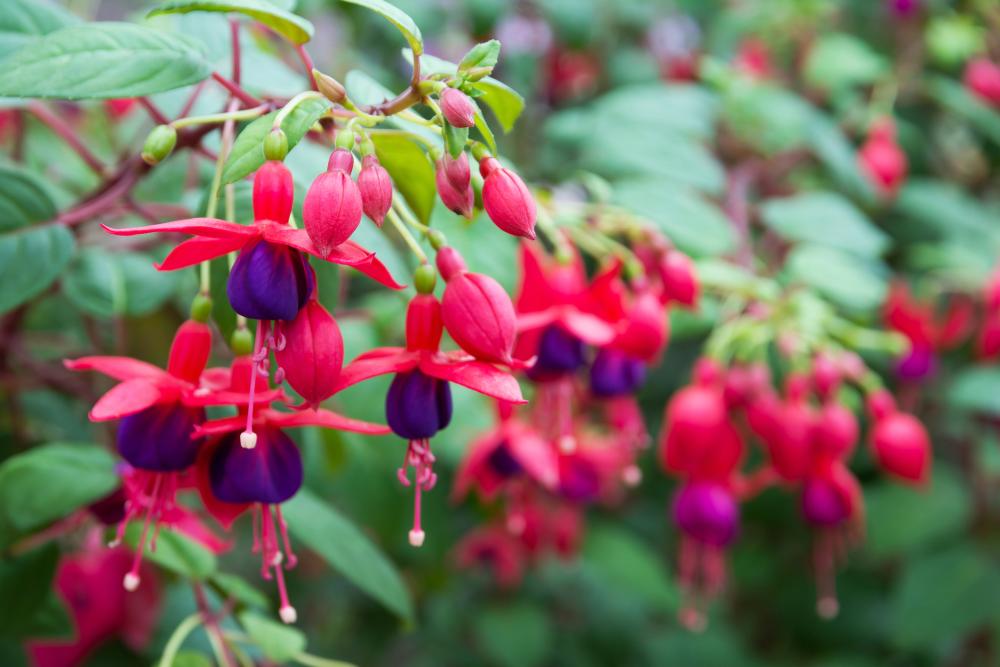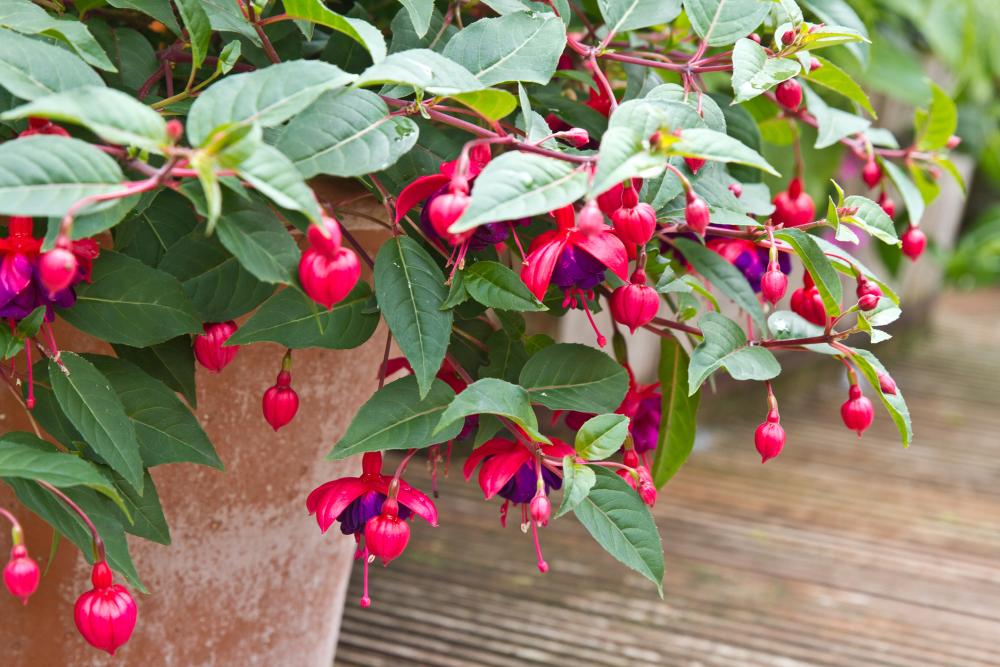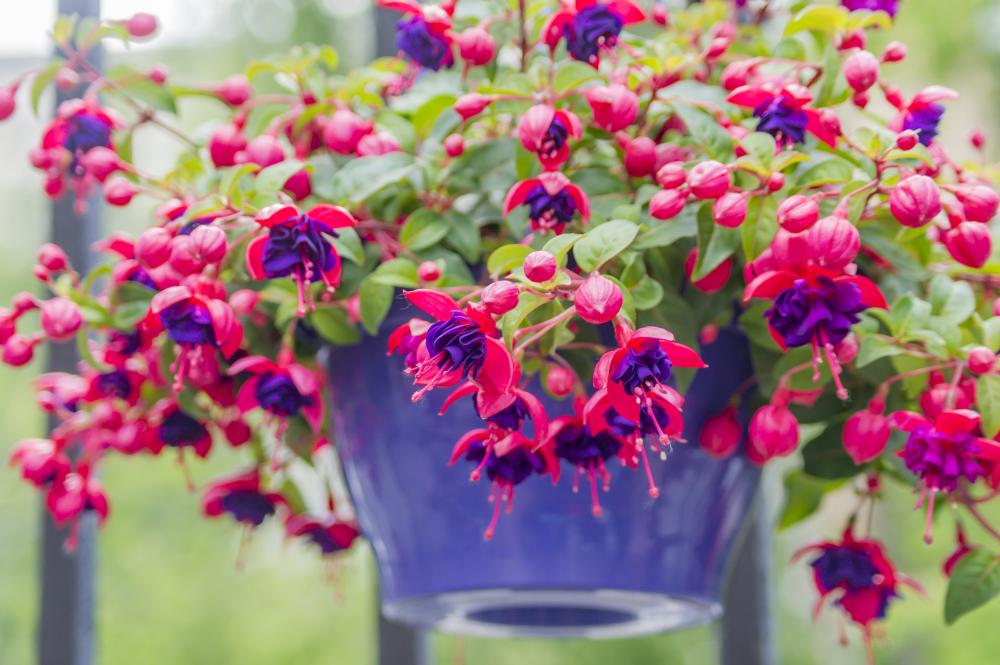How to Grow & Care for Fuchsia Plants
Typically grown inside hanging baskets, Fuchsias have more to convey besides their exquisite colorful flowers. If you aren’t scared about most of them not being frost-hardy, then owning a few Fuchsias would give you the thrilling experience that most other bloomers exhibit.
Their teardrop-shaped flowers are usually held by trailing stems—yet another exciting feature you’ll most likely adore. So, let’s check out the basics of growing and caring for Fuchsias. This guide will give you a fine print of everything.
More About Fuchsia Plants
So, here are a few basic facts you perhaps need to know. The Fuchsia is a successful genus in the world of gardening that comprises slightly over 100 types. They’re either trees or woody shrubs. Most of them are hybrids and are perfect for large containers, hanging baskets, or flower beds in your garden. Nearly all Fuchsia types have the vibrant energy to produce lots of bright flowers during the blooming season.
The perennial houseplants prefer a warmer environment. It’s also worth noting that apart from bushy and hardy Fuschias, there are trailing types that, besides their colorful display, are treated as half-hardy and ideal for hanging baskets. Those which are entirely hardy tend to be frost-tolerant. So, you have the option to pick a hardy type and treat it as an annual or choose one that needs to be moved indoors when it’s winter.
Fuchsia Varieties
There are a couple of Fuchsia cultivars to choose from. It all depends on whether you’re looking for the type that trails profusely while growing inside a hanging basket or one that spreads so wide in a large container. These are some of the popular options to try out:
- Fuchsia’ Swingtime’: This trailing type features white petals covered by dazzling red sepals. It’s perfect for hanging baskets. In cooler summer regions, this variety will bloom from June till October. Its densely ruffled petals and vibrant red stamens make this Fuchsia type have a winning floral pattern. The nursery hybrid grows best in USDA zones 8-11.
- Fuchsia’ Dollar Princess’: The ‘Dollar Princess’ usually has red and purple blooms that brighten your indoor space quite blissfully. Its color scheme presents a striking appearance, and the plant is mostly hardy. It can survive even when temperatures fall below 5 degrees Celsius. The houseplant is more like a shrub with woody stems that allow more tender growth during spring.
- Fuchsia’ Lady in Black’: If you’re looking for a type with potent trailing traits, the ‘Lady in Black’ still stands as a workable option. It climbs using twining tendrils and can hang tightly on a mesh fence. For a single growing season, the ‘Lady in Black’ will climb up to 2 meters. With deep pink sepals, each node can produce up to four flowers during the blooming period.
- Fuchsia’ Seventh Heaven’: The ‘Seventh Heaven’ is huge compared to most other Fuchsia types. And the other thing most gardeners adore about this hybrid is its double-blossom flowers. They’re white, while the under blossoms are pink. Besides having a joyous blooming cycle, it can trail up to 18′ inches when growing inside a huge container.
Fuchsia Growing Tips
Light & Temperature
Fuchsias need some bit of direct, filtered light every day. But there’s a limit to the amount of light they need to receive. Avoid keeping the growing medium in a position where it gets exposed to the afternoon hours. In areas such as the coastal line of California or Seattle, where summers are cool, you want to grow your Fuchsia houseplant in a location where it gets the full sun. Conditions in zones 10 and 11 allow you to treat this plant as a perennial.
To tweak the light conditions, place the container close to a window that’s facing north. It’s worth noting that any intense heat will scorch the foliage. Overall, it’s best to grow your Fuchsia plant under some partial shade. If temperatures go beyond 90 degrees Fahrenheit, you’re likely to see flowers and leaves dropping. High temperatures tend to halt the blooming phase. When it’s daytime, Fuchsias thrive incredibly under temperatures between 50 and 80 degrees F. Overwintering would be necessary if your Fuchsia is growing outdoors. We’ll talk more about how to overwinter later in this guide.
Soil Requirements
Fuchsias don’t demand any sophisticated soil structure. You can grow them in standard potting soil and still expect the bloomers to have laudable foliage throughout the seasons. Keep the soil evenly moist at regular intervals, but make sure not to leave it soggy. It’s also best to make the potting soil rich in organic matter. Peat moss and compost are usually viable sources of organic matter. During the blooming season, the buds will crave a few essential nutrients, so adding organic matter elevates the chances of producing flowers. Add a layer of organic matter at the base of each hole before planting the cuttings.
Both in-ground and potted Fuchsias will need to grow in soil that supports drainage reasonably well. In addition, the planting hole needs to provide sufficient space for the rootball. Since most Fuchsias are slow-growers, there won’t be any need for regular transplanting. Instead, grow these flowering plants inside containers with enough space to accommodate them for the most prolonged period possible. It’s, however, best to replace the old soil, say, once every year, to provide the houseplant with more nutrients.
Watering & Feeding
Fuchsias like to grow in an environment with high humidity. Therefore, keep the soil regularly moist but not soggy. Excess moisture getting stuck in the soil for too long could cause root rot. There are also chances the houseplant will fail to bloom. The effects of overwatering also tend to attract a swarm of fungal infections. When propagating, make sure to plant the cuttings inside containers with enough drainage holes that help let out any extra moisture. At the same time, you want to add an amendment such as peat moss or mulch to increase the rate of moisture retention.
And the reason for this is not to let the soil dry out entirely. During the blooming season, your Fuchsias will desperately crave essential nutrients. Therefore, this is the most optimal time for feeding. Pick a fertilizer that’s richer in phosphorus and potassium than nitrogen. It needs to be a soluble fertilizer that you can dilute at half its strength. You can feed your Fuchsia houseplant with organic remedies such as seaweed or fish emulsion. For hardy Fuchsias, an all-purpose granular plant food would suffice. Feed the houseplant every 7 to 10 days during summer and spring.
Grooming
Apart from providing the right amount of light and moisture levels, the overall maintenance routine won’t be elaborate. Once the blooming season is over, pluck off the withered blooms to leave room for newer growth during the next flowering period. Pruning also helps new growth to emerge. When growing inside a hanging basket, your Fuchsia will trail in a bushy pattern. Pinch the tips of the shoots to stimulate the production of more flowers.
Overwintering
You’ll need to bring your Fuchsias indoors when it’s freezing outside. First, dig them from the ground during autumn before the temperatures fall below 40 degrees Fahrenheit. The next step would be to spot a location that is free from frost. Then, cut the foliage back to at least half its size. They need to stay compact. Your Fuchsia will recoup its shape once the frosting period is over and the growth hormones have the zeal to bounce back. While overwintering your Fuchsias is essential, they still need their preferred humid environment. Also, make sure not to place them near a heater.
Instead, hunt for a dark and dry location—probably the garage. If your Fuchsias grow in pots, lightly moisten the soil to keep them from drying up. Once the frost period is over, replace the topsoil with compost or any other organic material that’s rich enough to add all the missing essential nutrients. Move the pots outdoors and as new growth begins to emerge, keep on trimming the branches until the first flower buds pop up.
How to Propagate Fuchsias
You can reproduce Fuchsias using stem cuttings. Take the cuttings during spring. To propagate the houseplant without any shortcomings, you need to:
- Identify stems that look healthy and make the cut right above the 3rd set of leaves. Take stem cuttings that are at least 4′ inches long.
- It’s best to choose cuttings that have no flower buds on them. If they do, get rid of the shoots.
- After pinching off the side shoots, remove any lower leaves too. Next, make a clean cut right below the leaf node.
- Your cuttings should have one or two pairs of leaves at most.
- Pick a small pot and prepare the potting soil. Mix the soil with horticultural grit and compost to improve the whole nutrient composition and drainage structure.
- Place your cuttings on the edges of the pot so they can have a firmer base.
- Keep the soil evenly moist. Water the cuttings till excess moisture is let out through the drainage holes.
- Cover the pot with a plastic bag, then seal it using an elastic band. Place it in a warm location to enhance sprouting.
- Keep the pot near a windowsill that doesn’t expose the cuttings to intense heat from the sun.
- Remove the plastic bag once new growth begins to show up. After a few weeks, move the cuttings into individual containers.
Common Fuchsia Problems
Although this flowering houseplant prefers a humid environment, the effects of overwatering often threaten its entire wellbeing. So, you want to avoid leaving the soil too soggy. Fuchsias are also prone to pests such as whiteflies, aphids, and spider mites. These pests can be mainly frustrating during winter after moving your potted Fuchsias indoors. Dip cotton swabs in alcohol and use them to get rid of any visible mealybugs. Some aphids settle deep in the roots, so it would be best to replace the entire potting soil. Neem oil or insecticidal soap is a perfect treatment for spider mites infestation.


